Full company details
Aperture Optical Sciences Inc.
 170 Pondview Dr.
170 Pondview Dr.
Meriden, CT 06450
United States
Lessons from the Past Shape the Future of Large Optics
Photonics Spectra
Sep 2024Specifications for large-format optics have changed. The next wave of commercial large optics must adapt.FLEMMING TINKER, APERTURE OPTICAL SCIENCES INC.
In the 1990s, several daunting technological challenges converged, redefining both the perception and parameters of large optics. With the unprecedented demands of initiatives,
such as the Lawrence Livermore National Laboratory’s (LLNL’s) National Ignition Facility (NIF), the James Webb Space Telescope, the Extremely Large Telescope (ELT), and numerous other large telescope projects on the drawing board, the optics industry required a scale-up and new levels of performance. In the electronics sector, meanwhile, new-to-emerge classes of consumer and industrial devices demanded large-format, defect-free glass panels, which further influenced the upward growth trajectory of large optics.
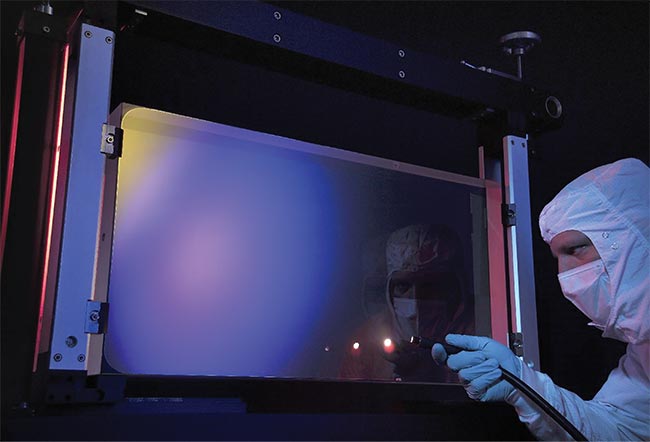
The engagement of industrial experts early in the design stage of the National Ignition Facility (NIF) catalyzed innovative ideas. Technology development included advancing large aperture application magnetorheological finishing, computer-controlled pitch polishing, and high-resolution large-format interferometry, among others. Today, large optics technology faces another inflection point. Courtesy of Lawrence Livermore National Laboratory.
Now, another inflection point has emerged to facilitate the future of large optics, motivated this time by the expansion of laser fusion technology and the strategic demand for directed energy defense systems.
From historic scale-up projects in astronomy and high-energy laser systems, leaders in the optics industry have learned valuable lessons that will guide the field forward. With new growth drivers creating a set of challenges, which are still evolving, it has never been more critical to understand and consider the perspectives of leading professionals. As industry broadly readies to adjust, a look to the past provides valuable insights to chart the course ahead.
How large is large?
In the 1980s, “large optics” generally enveloped any class of optics having an aperture >4 in. Even today, the majority
of optics produced are this size or smaller, though the technology and global capability for optics of up to 300 mm is not uncommon. Surface finishing and metrology and coating technology have matured in response to 300-mm-class semiconductor wafers and requisite lithography technology. In many circles, large optics begins with elements or components of 0.5 m and describes any optic greater than this size.
This is not to say that large optics is a nascent concept. Since Lord Rayleigh
described the inverse relationship between aperture and resolution, scientists have pushed designers and manufacturers to develop larger telescopes to improve the detail of images. Increased aperture also provides for larger light collection as well as improved signal strength to more deeply penetrate the heavens and reveal new exoplanets and the presence of life.
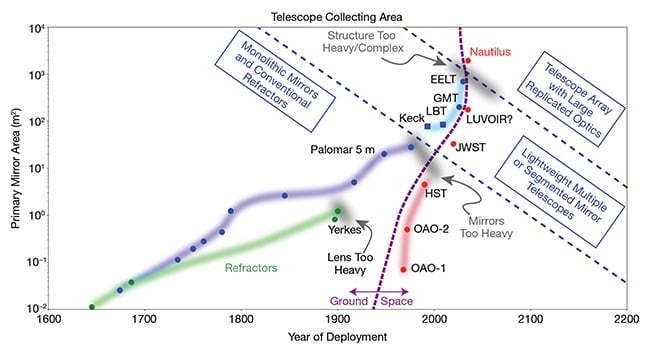
The evolution of primary mirror collecting area(s) for individual instruments over time, with remarks indicating the key technology inflection points. The primary mirror collecting area, also known as the light-collecting area, is the total amount of area that reflects light onto the telescope instrument’s secondary mirror. Courtesy of University of Arizona College of Optical Sciences and Steward Observatory.
This is a strong motivator for expanding the role and manufacturability of large optics. For example, the authors of a 2019 publication introducing the Nautilus space array concept presented an illuminating commentary on the history and technology drivers of large optics for astronomy
1. Their analysis showed that by the early 20th century, materials and mass limited the feasibility of refractive telescopes to ~1 m. And while extraordinary efforts could produce monolithic primary mirrors as large as 5 m in diameter — for example, the Hale Telescope Primary Mirror — the technology that is required to create precise wavefront quality ultimately proved to be limiting.
The next major technological leap introduced segmented mirrors with lightweight cores. Materials development, along with enhanced finishing capability
provided by computer-controlling polishing, enabled many of the most ambitious telescopes — and, as a result, some of
the most ambitious large optics manufacturing projects. These include the Keck Telescopes, the James Webb Space Telescope, and massive primary mirror arrays, such as the Thirty Meter Telescope (TMT), and the 39.3-m-diameter primary mirror for the European Extremely
Large Telescope (EELT). In each of these cases, numerous primary mirror segments must be exquisitely fabricated over
dimensions on the order of 1.5 m each. The modern-day effort to produce the 8.4-m primary mirror segments for the Giant Magellan Telescope, for example, necessitates a hybrid approach to giant
aperture mirrors in a lightweight segmented form.
Construction efforts on the TMT and ELT remain incomplete. It is still unclear, and perhaps doubtful, as to whether this technology will be the preferred solution for even larger terrestrial telescope projects. One such undertaking, the Overwhelmingly Large Telescope (OWL), requires 3264 individual mirror segments to achieve a primary mirror array anticipated to be 100 m in diameter.
The throes of fusion energy
The requirements of the NIF posed an extraordinary question to the teams of designers charged with developing the optics for this device in the early 1990s: “What will it take to make the 7000-m-scale optics required by the facility — a high-energy laser laboratory housing 192 laser beams, each having a cross-sectional aperture of 40 sq cm — in three years?”
This was not the only requirement facing industry. It was
necessary to produce the optics for 20% of the present-day cost.
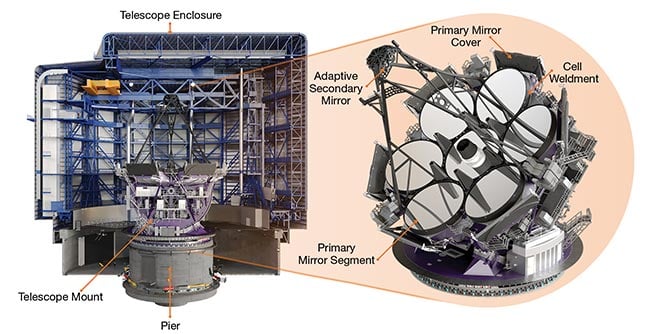
The production of primary mirror segments for the Giant Magellan Telescope commands a hybrid approach to giant aperture mirrors in a lightweight segmented form. The seven primary mirrors of the telescope, which is currently under construction, are sized at 8.4 m. Courtesy of Giant Magellan Telescope — GMTO Corporation.
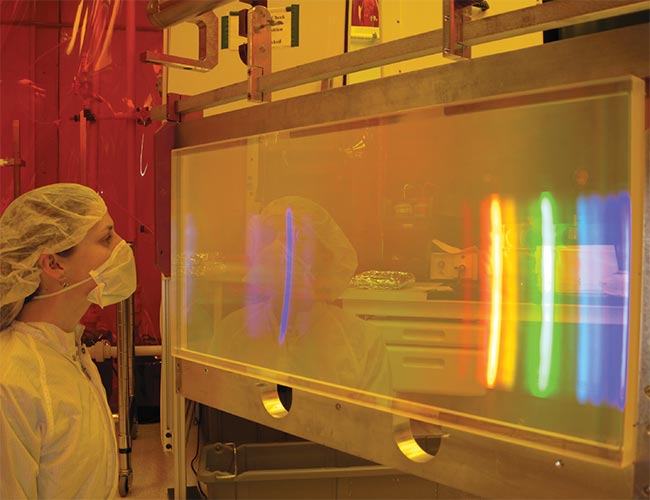
Diffraction gratings are among the optical components that a 2024 report from the Emerging Technology Institute and National Defense Industrial Association cited as necessary to scale up to bolster the directed energy weapons (DEWs) manufacturing base. Courtesy of Plymouth Grating Laboratory.
In response, one of the industrial teams produced three
scenarios to consider. First, how many people and machines would it take to fabricate the necessary optics using current methods and technology? Second, what would be the effect of modern industrial engineering principles, including production engineering, line balancing, and integrated flow management?
Finally, what would a future production facility look like with new, innovative technologies that are yet to be developed?
Questions two and three ultimately combined to yield the only practical solutions. Even if the entire global capacity was pooled, the designers would still lack a feasible way solve the scale-up problem with brute force capacity expansion.
More than 15 years after the optics manufacturing team first considered these questions, and roughly 10 years since the start of construction on the NIF, researchers prepared to test the
facility in early 2009. Looking back on 10 years of operations, the NIF team remarked in 2019
2:

The functionality of large optics is vital to the successful development and online capabilities of fusion energy plants. This conceptual fusion power plant is poised to support the global energy market. Courtesy of Fluor Corporation/Longview Fusion Energy Systems.
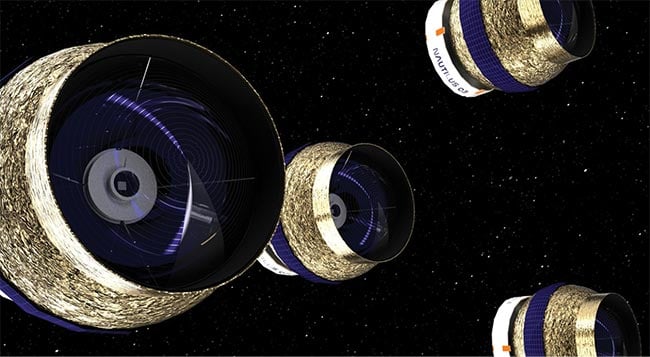
The Nautilus Space Observatory concept uses a constellation of ultralightweight multi-order engineered diffractive (MODE) lenses. These optics can be mass-produced quickly, and in cost-efficient ways by precision glass molding. Since they are transmissive optics, they are much less sensitive to misalignment, making them cheaper and easier to replicate. Courtesy of University of Arizona College of Optical Sciences and Steward Observatory/Dániel Apai.
On March 9, 2009, a staggering 2 trillion watts of electrical power — 4 times more power than the United States uses at any instant in time — surged through the NIF to generate the intense light that powers the laser. At that moment, 192 laser beams raced down the beam path and converged to deliver an immense blast of energy onto a tiny target. This test shot was a key milestone for NIF, fulfilling one of its first critical design specifications.
According to Chris Stolz, associate program manager for NIF and Photon Science optics supply at LLNL, the journey to realizing a functional NIF imparted valuable lessons that can provide guidance on how to meet demands for large optics in the future.
First, rethinking the ways that optics are specified is a core consideration. The NIF optics worked as designed because the team adopted a new way of characterizing and measuring wavefront error(s). Conventional specifications, such as peak-to-valley wavefront error(s), were replaced in the hierarchy of importance with controls on mid-spatial frequency errors using high-resolution characterization of wavefront slope and placing constraints on errors in the high-, mid-, and low-spatial frequency regime(s). This change ushered in new disciplines and
demands on manufacturing and metrology.
The takeaway: Do your best to connect quality metrics as close as possible to performance objectives, even if it means replacing established standards. The future will require its own set of “new” standards.
For a project of the NIF’s magnitude and scope, the need to adapt existing capabilities eventually feeds into a need to
develop new technology. The NIF project team empowered
industry to develop solutions to address capacity, workforce development, and production throughput. Other unrelated technology developments proved to be essential to the available
industry solutions. The availability of megapixel cameras and fast computers changed the game, while high-resolution detectors enabled interferometers to see more detail in wavefronts, and faster processing meant that statistical controls could be employed to obtain more accurate results. Better measurement technology ensured better process control as well as more quantitative approaches to optics fabrication.
The NIF team’s engagement with industrial experts early in the design stage incubated innovative ideas by funding new technology development. Essential technology development was funded in preparation for the production phase of NIF. These technologies included advancing large-aperture application of magnetorheological finishing; computer-controlled pitch polishing; electrolytic in-process dressing grinding; potassium dihydrogen phosphate (KDP) crystal growing; high-resolution large-format interferometry; and advanced facility and production flow simulation. Successful developments were exploited, and ineffective ideas were excised through a pilot production phase. New technologies were made robust by exercising the tools and methods with sufficient preproduction work to establish reliable methods. These potentially risky innovations proved to be essential because they were championed early.
Large optics in fusion energy: the future
In the landmark demonstration on Dec. 5, 2022, NIF scientists demonstrated the release of 3.15 million joules of energy compared with the 2.05 million joules focused on the target. Fusion energy gain was demonstrated using lasers for the first time. This advancement, along with the proliferation of experimental high-energy laser facilities around the world, portends the necessity of a new age in large optics demand. The awarding of two Nobel Prizes for seminal achievements in this area of photon science since 2018 has only affirmed the vitality of this growing field.
In consideration of the projected demand for large optics in the next two decades, the field must drive several necessary changes. First, and simply, the optics must get larger. Due to
fundamental limits in the materials required for reflective coatings, the incident laser energy reflecting off their surfaces progressively destroys today’s commercially available coatings.
From this consideration of laser-induced damage threshold (LIDT), today’s optics have evidently reached a limit.
Researchers from industry and academia are actively studying how to increase LIDT, although the physics imposes barriers. One solution to the problem of keeping today’s lasers operational is to create a huge stockpile of spares and immediately replace and recycle them as they fail. Another option is to spread the incident energy over a larger surface area by making the optics larger. This would necessitate that 40-cm beams grow to 60 cm, 80 cm, or even larger to satisfy the demand of greater energy handling. In either case, laser optics must get larger. They must also be made faster, cheaper, and in higher quantity.
Perhaps the best indicators for the future of large optics in the domain of laser fusion come from purely application considerations.
Stolz made the following observation: Consider the following ratios. The NIF currently believes that gains of 15×
may be possible in the next decade, which is what would be needed for a self-sustaining fusion demonstration plant, with gains of 50 to 100× required for a commercial electricity-producing plant.
If fusion were to match the scale of fission power today in the U.S., it would require
constructing approximately 100 fusion
plants. With the rising demands for energy, and preferably clean energy, it is conceivable that the nation will need far more than that, and we would want to build plants at a rate of several fusion power plants per year.
The NIF took 10 years to build. These numbers imply that we need to scale up the industrial capacity for NIF-like large optics by a factor of 100. These are staggering numbers and represent a much larger challenge than those that optics designers and society faced in the 1990s.
Reflecting on the lessons learned, it is necessary to prepare early, rethink specifications, exploit broader industrial advancements, and innovate ways to make laser transport and focusing devices. It is more about developing bigger ideas than making bigger manufacturing machines.
Ultrahigh energy delivery
Fusion energy is not the only tailwind spurring large optics innovation. Under the umbrella of national defense, strategies for missile and drone defense open the door to directed energy weapons (DEWs) that require highly precise large optics.
These optics are similarly vulnerable to the same failure mechanisms as fusion energy optics, highlighted by laser damage threshold. The solutions at hand are also much the same: Make optics larger, and with new advanced materials that can endure higher fluence(s) at longer durations.
A national survey of the U.S. directed energy industrial base, “Directed Energy Weapon Supply Chains,” published earlier this year by the Emerging Technology Institute and National Defense Industrial Association, reached several conclusions. First, the report found that the current DEWs manufacturing base is capable of producing only small numbers of systems, rendering it insufficient to support fielding DEWs at scale. Long lead times for the assembly and delivery of these systems further hinders the manufacturing base, and its recipients in the national defense community as a result.
The report further concluded that
efforts to scale up production would quickly run into issues, including producing optical components, such as diffraction gratings, mirrors, and lenses, as well as beam directors, batteries, and the regulatory regime governing what the report characterized as, “above-the-horizon DEW testing.” The Emerging Technology Institute and National Defense Industrial Association ultimately recommended the establishment of DEW programs of record that provide clarity on future system demands plus the standardization of requirements for DEW systems, components, and testing. And the agencies advised harnessing technology from the commercial industry when possible.
The report additionally cited current DEW workforce shortages in the areas of optics, optical coatings, and energy production. As a result, upscaling production for DEWs faces a challenge: The current DEW workforce is insufficient to support upscaling DEW production, according to the report. “As such, [the Department of Defense] should expand existing workforce development efforts by establishing a DEW University Consortium with the specific goal of creating a strong workforce to meet future DEW needs,” according to the report.
Finally, the report highlighted the vulnerabilities that DEW supply chain(s) face, particularly due to limited suppliers of beam directors, adaptive optics, optical coatings, specialty optical fiber, beam dumps, ceramic laser materials, and fused silica. “While the overall financial health of directed energy companies is relatively stable, the failure of even a single company could have severe repercussions due to limited supplier concerns,” the report said.
Ideas for an evolving industry
Given the volume of work needed to meet the anticipated forthcoming demand for large optics technologies, it is open season for ideas that provide solution paths to current challenges. Diffractive optics is one technology that could hold an answer for very large telescopes. Innovative concepts, such as the Nautilus Space Observatory, may enable extraordinary light collection capability, comparable to a 50-m primary mirror.
The Nautilus concept uses a constellation of ultralightweight multi-order engineered diffractive (MODE) lenses developed at the University of Arizona College of Optical Sciences and Steward Observatory. According to Dániel Apai, principal investigator for the Nautilus Array, MODE lenses can be mass-produced quickly, and in cost-efficient ways by precision glass molding. And, since they are transmissive optics, they are much less sensitive to misalignment, making them cheaper and easier to replicate. This quality, Apai said, is vital for resilient satellite constellations.
Downstream, the continued advent
of metamaterials and nanostructured surfaces on large substrates could change the way industry views and uses large optics for high-energy lasers. Companies, such as Desktop Metal, have helped to reshape the additive manufacturing industry and are actively innovating materials-enabled products with advanced printed ceramics
for optical applications. Desktop Metal has already brought printed silicon carbide substrates of up to 1.8 m in size to commercial readiness, and the technology to produce wide-area nanostructures is within grasp. These foundational technologies may be the answer to creating
large-aperture athermal optics without
the need for traditional grinding and polishing.
Further research into additive manufacturing replication and nanostructured diffractive optics could reveal transformative pathways for how large optics will be made in the decades to come. Optics that are more lightweight, better able to manage heat, and more resilient to intense energies will demand changes to the modern optics factory.
Resistance to such changes and challenges in workforce development came within reach of defeating the U.S. optics manufacturing industry in the 1980s. This memory, the need for large optics technologies, and the technologies already deployed today will need to combine to drive change once again to meet the needs of tomorrow.
Meet the author
Flemming Tinker is the founder and president of Aperture Optical Sciences Inc. He has been a developer of large optics and imaging technologies for more than 35 years and has advised optics companies worldwide; email:
[email protected].
References
1. D. Apai et al. (2019). A thousand Earths: a very large aperture, ultralight space telescope array for atmospheric biosignature surveys.
Astron J, Vol. 158, No. 2,
pp. 83, 21.
2. Lawrence Livermore National Laboratory (June 2019). National Ignition Facility
celebrates 10 years of operation.
Science
& Technology Review, pp 5-11.